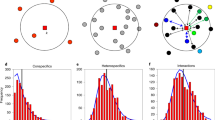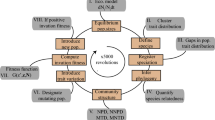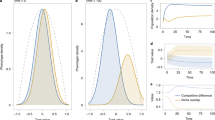Abstract
ECOLOGISTS typically explain the absence of a species in an area by searching for ultimate climatic or physical factors that limit its distribution or favour its competitors. The possibility that the system is not in equilibrium—that colonisation has not occurred—is not normally considered. Even less appreciated is that there may be a number of alternative stable equilibrium communities which may develop in a given area and that the final outcome may depend solely or partially on historical factors such as the sequence and numbers in which each species colonises. Here we investigate the theoretical possibility of this proposition for competition communities.
This is a preview of subscription content, access via your institution
Access options
Subscribe to this journal
Receive 51 print issues and online access
$199.00 per year
only $3.90 per issue
Buy this article
- Purchase on Springer Link
- Instant access to full article PDF
Prices may be subject to local taxes which are calculated during checkout
Similar content being viewed by others
References
Sutherland, J. P., Am. Nat., 108, 859–874 (1974).
Alexander, M., Microbial Ecology, 551–533 (Wiley, New York, 1971).
Park, T., Ecol. Monogr., 18, 265–307 (1948).
Heatwole, H., and Levins, R., Ecology, 53, 531–533 (1972).
Diamond, J., In Ecology and Evolution of Communities (edit. by Diamond, J. and Cody, M.), 342–444 (Belknap and Harvard University, Cambridge, Massachusetts and London, 1975).
May, R. M., Model Ecosystems (Princeton University, Princeton, 1973).
Gilpin, M. E., J. theor. Biol., 5, 333–344 (1974).
Roughgarden, J., Am. Nat., 106, 683–718 (1972).
Lotka, A. J., Elements of Physical Biology (Williams and Wilkins, Baltimore, 1925).
Volterra, V., Lecons sur la Theorie Mathematique de la Lutte pour la Vie, 131 (Gauthier-Villars, Paris, 1931).
Author information
Authors and Affiliations
Rights and permissions
About this article
Cite this article
GILPIN, M., CASE, T. Multiple domains of attraction in competition communities. Nature 261, 40–42 (1976). https://doi.org/10.1038/261040a0
Received:
Accepted:
Issue Date:
DOI: https://doi.org/10.1038/261040a0
This article is cited by
-
Exclusion and multiplicity for stable communities in Lotka–Volterra systems
Journal of Mathematical Biology (2021)
-
Competitive coexistence of seasonal breeders
Journal of Mathematical Biology (2021)
-
The stability of mutualism
Nature Communications (2020)
-
Fine-scale temporal turnover of jarrah forest understory vegetation assemblages is independent of fire regime
Fire Ecology (2019)
-
The feasibility and stability of large complex biological networks: a random matrix approach
Scientific Reports (2018)
Comments
By submitting a comment you agree to abide by our Terms and Community Guidelines. If you find something abusive or that does not comply with our terms or guidelines please flag it as inappropriate.



